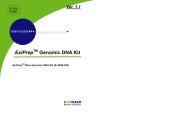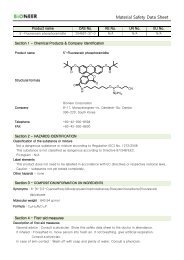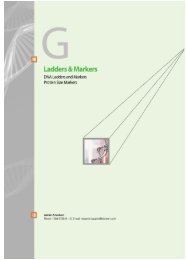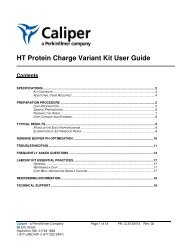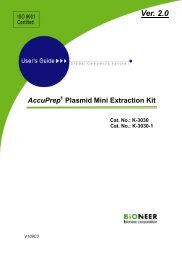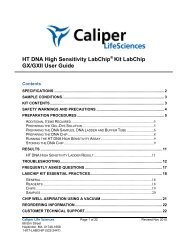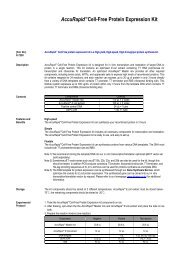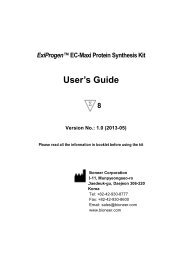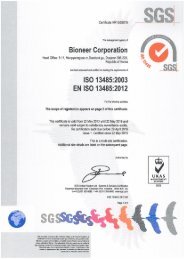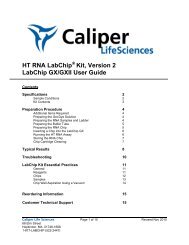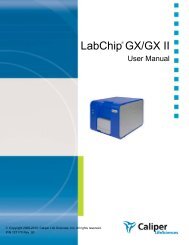ProfilerPro Glycan Profiling User Guide - PerkinElmer
ProfilerPro Glycan Profiling User Guide - PerkinElmer
ProfilerPro Glycan Profiling User Guide - PerkinElmer
You also want an ePaper? Increase the reach of your titles
YUMPU automatically turns print PDFs into web optimized ePapers that Google loves.
<strong>ProfilerPro</strong> <strong>Glycan</strong> <strong>Profiling</strong> Kit, Ver 2, <strong>User</strong> <strong>Guide</strong>3. Carefully remove plate seals.4. Transfer all (~11μL) denatured sample to PNGase F Plate. Mixby pipetting up and down or with a plate shaker.5. Seal plate carefully with an adhesive plate seal. (Note: Ensurethe plate is completely sealed to prevent evaporation.)6. Spin PNGase F Plate at 1200g for 1 minute.7. Incubate for 1 hour at 37C using a PCR machine (with lidtemperature at 37C), heat block, or incubator.Labeling1. Thaw Dye Plate.2. Spin both Dye Plate and PNGase F Plate at 1200g for 1 minute.3. Carefully remove plate seals.4. Transfer 8μL of Digested sample to the Dye Plate. Mix bypipetting up and down or with a plate shaker.5. Spin Dye Plate at 1200g for 1 minute.6. Incubate the unsealed plate for 2 hours at 55C (or until sampleis completely dry) using a PCR machine (with lid open) or heatblock. Caution: The dye contains acetic acid. Be wary offumes. Incubating under a fume hood is recommended.Sample must be completely dry to ensure sufficient labeling.Hints:Break point: If needed, after digestionsamples may be frozen at -20C andlabeled the next day. Overnightdigestion is not recommended.Incubators: Performing the incubationfor the labeling in an incubator or ovenis not recommended. If using anincubator for the labeling step, becareful of acetic acid fumes whenopening the incubator door. Also,carefully inspect samples to ensurethey are completely dry. It’s likely thatusing an incubator or oven willincrease the drying time to more than 2hours.Can more than 8μL of digestedsample be labeled?Sample buffer conditions resulting inoptimal glycan peak intensity wasobserved when labeling 8μL of thedigested sample. Labeling more orless will result in lower signal intensity.Break point: If needed, after labelingReconstitutiondried samples may be sealed andstored frozen at -20C and reconstituted1. Add 100μL of molecular grade water to dried samples.the next day. Overnight labeling is notrecommended.2. Seal plate carefully with an adhesive plate seal. (Note: Ensurethe plate is completely sealed to prevent spilling during mixing.)Mixing: It is best to use a plate shaker3. Mix samples on a plate shaker at maximum speed for at least 1 with max speed of at least 2000 rpm,minute. Check to be sure the pellet has completely dissolved.and Amplitude = 2mm for thereconstitution step If a plate shaker4. Spin plate at 1200g for 1 minute. (Note: After spinning there may be a white pellet at the bottom of the wells.Be careful not to disturb the pellet as it may cause a chip sipper clog.)5. Carefully remove plate seal and the plate is ready to run on your LabChip GXII.Caliper Life Sciences Page 5 of 21 PN: 45070968 Elm StreetHopkinton, MA 01748-16681-877-LABCHIP (522-2447)



